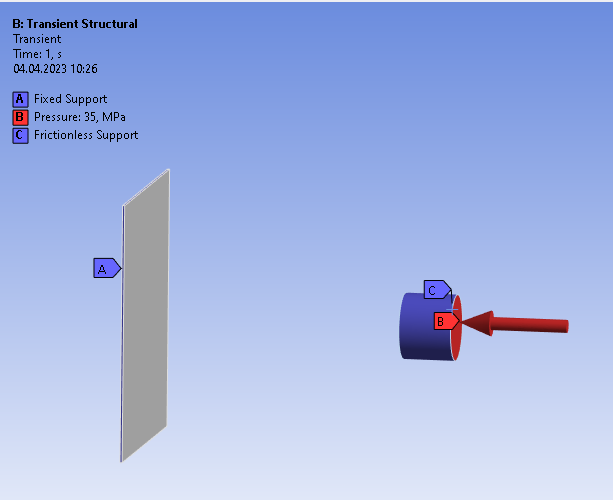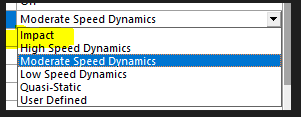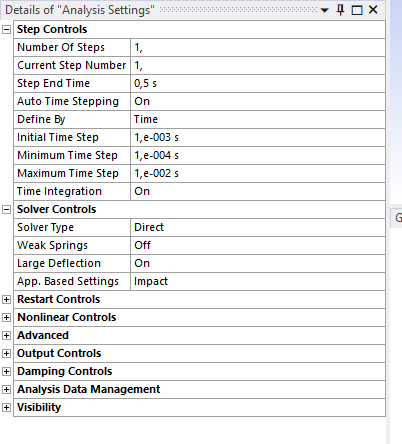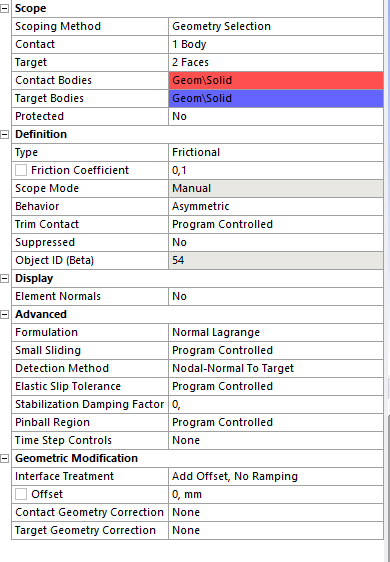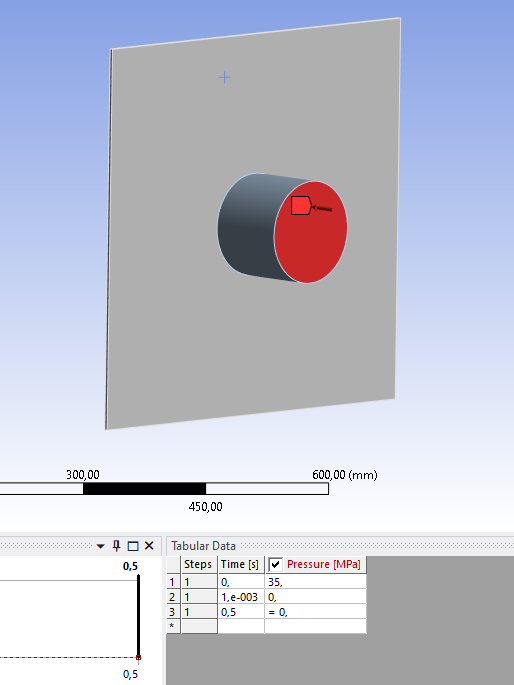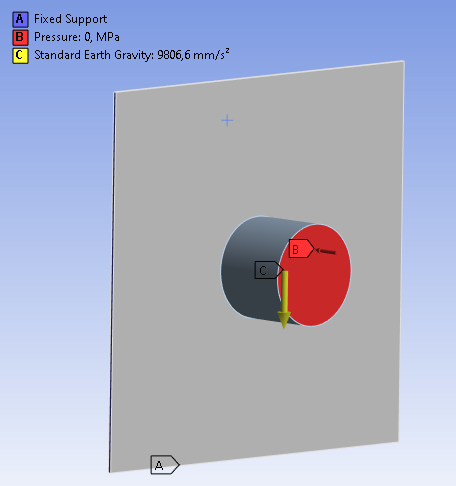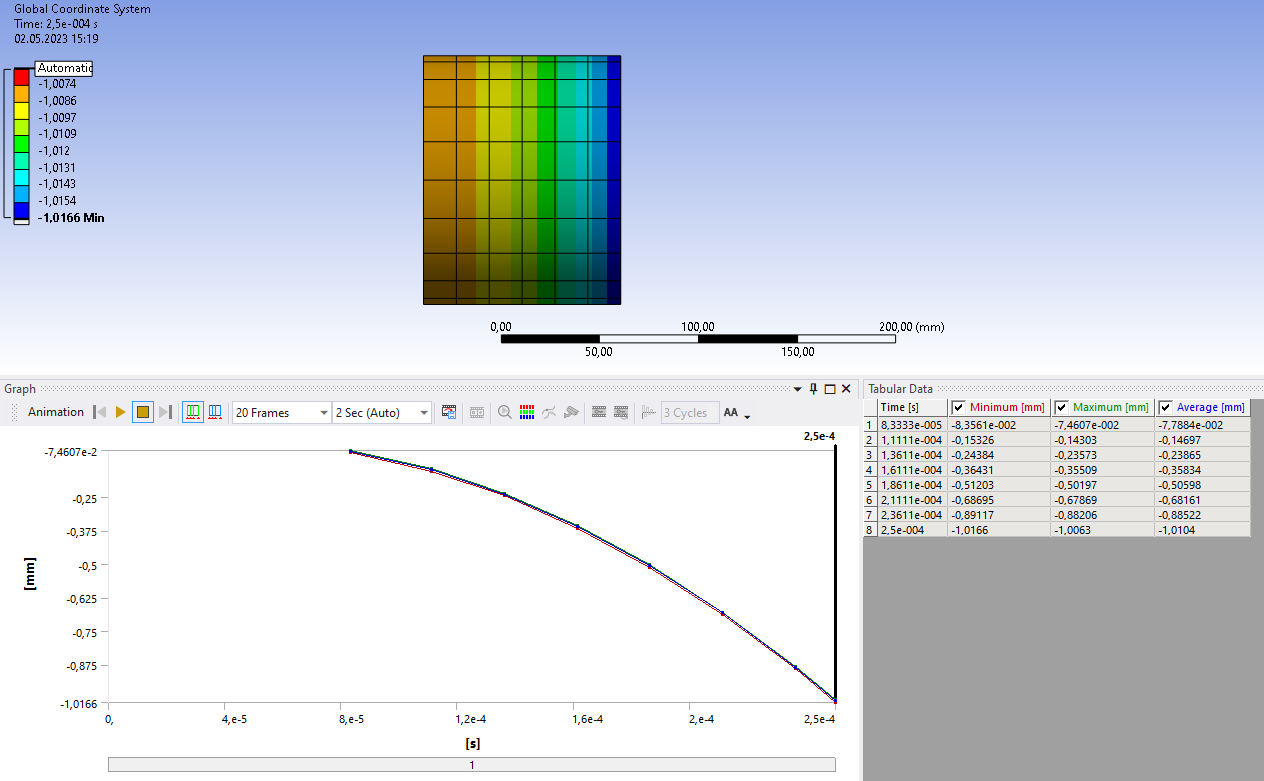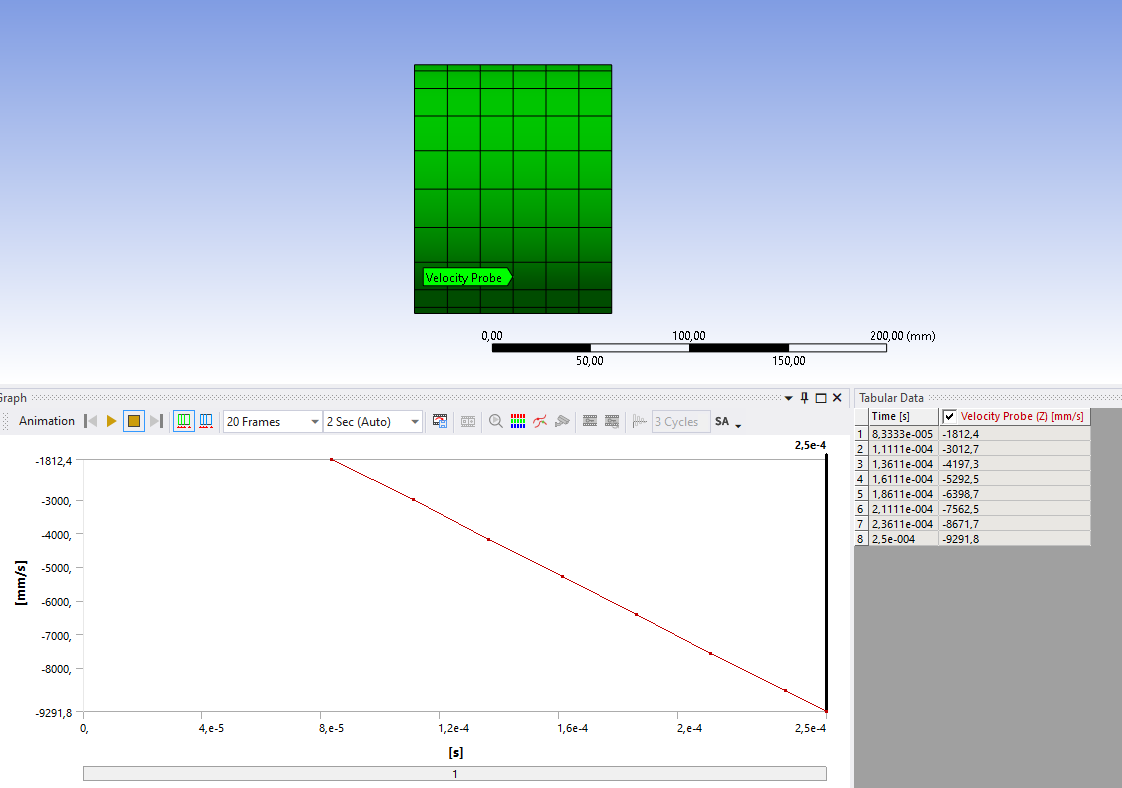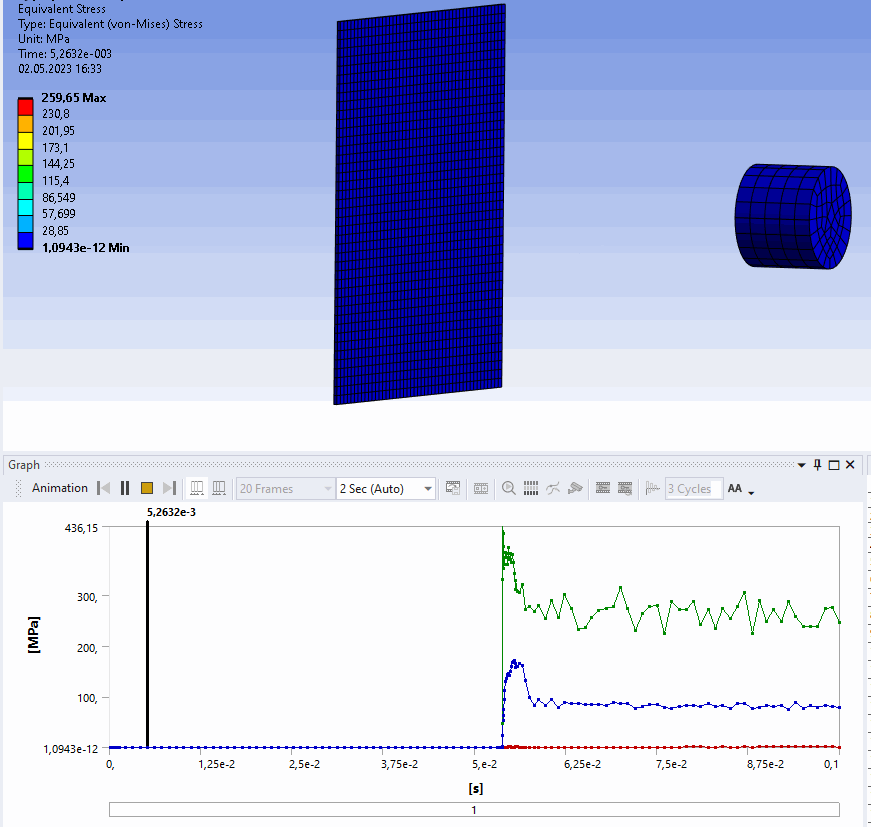-
-
April 4, 2023 at 7:36 pm
javat33489
SubscriberHi all.
I do a shock calculation in transient analysis. The initial data are as follows, the cylinder moves towards the steel sheet. There is no initial speed, but there is pressure on the cylinder, which is 35 MPa. I simulate that during operation the plug on the product came off and flew into the protective fence.
- Is it possible to set the initial pressure as the initial speed? There is no such thing in the program.
- Is it possible to find the initial speed from the pressure?
If I set the pressure on the cylinder, then the calculation ends with an error.
In the settings I also chose impact:
-
April 7, 2023 at 5:36 pm
Chandra Sekaran
Ansys EmployeeYou can start with zero initial velocity (that is the default initial condition in ANSYS). Then based on the force and the mass of the cylinder (F=ma), the cylinder will begin accelerating.
-
April 7, 2023 at 8:28 pm
javat33489
SubscriberAdd an initial speed of 0, while the pressure remains?
-
-
April 7, 2023 at 8:42 pm
peteroznewman
SubscriberWhat is the time history of the pressure. I don't expect it is present for all time.
-
April 8, 2023 at 10:32 am
javat33489
SubscriberYes, it is not always. I'm trying to simulate a cap tearing off a pipe. During separation, a pressure of 35 MPa acts on the head. The plug flies into the protective sheet and I have to check if it breaks through this sheet.
-
-
April 8, 2023 at 1:10 pm
peteroznewman
SubscriberIf you have a pressure load, you need the time history of that pressure to compute the final velocity.
It will be simpler if you assign an impact velocity to use as the Initial Condition velocity of a cap that is just touching the sheet. Then the mass of the cap and its initial velocity completely defines the energy in the system at t=0 for the sheet problem.
-
April 14, 2023 at 7:24 pm
javat33489
SubscriberI came up with this idea. I moved the die close to the fox so that the contact closes. Then he made a calculation for 0.5s and pressed the pressure for a fraction of a second for 0.001s. I created an impulse to hit the sheet with a die, thereby checking the sheet for penetration. Of course, the impact force from a flying die would be less. But I do not have time, so I applied this method.
What do colleagues say?
I did not use the stabilization damping factor and specified the IMPACT in the solver.
-
April 16, 2023 at 5:27 pm
javat33489
SubscriberWhat do colleagues say?
-
-
-
April 8, 2023 at 3:47 pm
dlooman
Ansys EmployeeAs suggested in the previous post, it's not a good idea to solve for the rigid body motion of the plug as it flies toward the sheet. For one thing that motion can be easily hand calculated. Mainly though, the problem is that the plug will probably fly right through the sheet. In one time step the plug will go from not reaching the sheet to being beyond it and contact will not have occurred. The suggestion above avoids this and provides a good solution at the instant of contact.
-
April 8, 2023 at 7:51 pm
javat33489
SubscriberYes, moving the cap to the sheet is a very good option. But apart from the pressure at the moment of separation from the pipe, I have no other input data. How then to solve this problem?
-
-
April 10, 2023 at 3:07 pm
dlooman
Ansys EmployeePerhaps a CFD analysis could compute the drop off in pressure, but to make progress on a purely mechanical analysis you could make an engineering guess on how long the pressure is applied to the plug.
-
April 15, 2023 at 7:08 pm
javat33489
SubscriberI have attached the new idea and animation above in response
-
April 17, 2023 at 6:38 pm
javat33489
SubscriberWhat do you think about my idea? -
April 25, 2023 at 5:11 pm
-
April 27, 2023 at 6:44 pm
javat33489
SubscriberWhat do you think about this?
-
-
April 30, 2023 at 7:52 pm
javat33489
SubscriberI need help guys
-
April 30, 2023 at 8:15 pm
dlooman
Ansys EmployeeThe most important input quantity in an impact analysis is the velocity of the cylinder at impact. I wouldn't even include the gravity and pressure loads. You're going to have to make an educated guess on what velocity the projectile reaches and then specify that as an Initial Condition.
-
April 30, 2023 at 8:24 pm
javat33489
SubscriberI have already written many times, I do not know the speed! I only have pressure!
-
-
April 30, 2023 at 8:51 pm
peteroznewman
SubscriberDave Looman already said "a CFD analysis could compute the drop off in pressure" and I agree that is one way to estimate the impact velocity.
-
May 1, 2023 at 2:36 pm
dlooman
Ansys EmployeeOr perhaps you could make an assumption like the pressure on the plug would drop off after the plug traveled 1 inch. Perhaps this could be an upper bound solution. Then you could calculate the velocity at 1 inch of travel under full pressure and say it was an upper bound. Applying this initial velocity in an impact analysis would at least give you a data point.
-
May 1, 2023 at 5:21 pm
javat33489
SubscriberInteresting idea, I'll try it.
-
-
May 1, 2023 at 5:22 pm
javat33489
SubscriberHow to calculate the speed you offer in CFD? Can you tell me more about how to do this? -
May 2, 2023 at 5:33 pm
javat33489
SubscriberColleagues, I did it. I measured the time of flight of a 1 mm plate under pressure and used it as the initial speed:
Speed 9291 mm/s
Here's what happened at that speed:
Max stress 436 MPa, material tensile strength 450 MPa. This means that the part severely damaged the shield, but did not break through it. Everything is fine?
-
May 2, 2023 at 7:02 pm
peteroznewman
SubscriberIf the plate material is a ductile metal, you can get a more realistic simulation by adding plasticity to the material model. The simplest one is Bilinear Kinematic Hardening as it has only 2 inputs, Yield Strength and Tangent Modulus which you can set to 0. This is a conservative assumption since a real material will have a non zero tangent modulus. If the projectile bounces off that material, that would be better than what you are showing which I assume has a linear elastic material model.
-
May 3, 2023 at 1:55 am
javat33489
SubscriberThank you very much sir. I will add plasticity to the wall.
And the solution itself is normal, as suggested by Dave Looman?
-
-
May 3, 2023 at 1:27 pm
peteroznewman
SubscriberI think it is unrealistic that the cap will hit the plate at a flat orienation, spreading the impact over the largest possible area. The worst case is the cap is oriented at 45 degrees and the edge corner makes contact with the plate and creates a much higher peak stress.
-
May 3, 2023 at 4:55 pm
javat33489
SubscriberYes, you are right, but as an initial basic calculation can be used.
-
-
May 3, 2023 at 1:33 pm
dlooman
Ansys EmployeeIt still appears you are starting the analysis with the cylinder far away from the target. Are recommendation has been to model the cylinder in contact with the target. Nothing is happening in the time before impact so it is wasted computation, but more important there is a risk the cylinder will over-penetrate the target. As mentioned, plasticity frequently occurs in impact problems. In the APDL Verification Manual, VM265 is a very plastic impact analysis of a copper cylinder.
-
May 3, 2023 at 4:58 pm
javat33489
SubscriberYes, I put the cylinder at a distance of 500 mm from the wall, as it stands in reality. I posted a lot of substeps so the detail didn't penetrate through. You are right, of course it is better to move the parts close to the closed contact. Over 500 mm, the speed is lost, you can calculate what speed will be 500 mm after the initial one and put the parts close. Thank you very much for your help!
-
-
- The topic ‘Pressure shock calculation in transient’ is closed to new replies.



-
4673
-
1565
-
1386
-
1236
-
1021

© 2025 Copyright ANSYS, Inc. All rights reserved.

